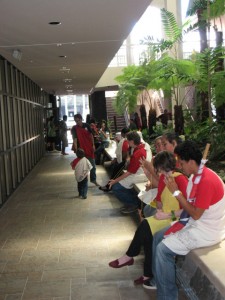Thirty Meter Telescope Approval Challenged in Court
A coalition of native Hawaiians, environmentalists and other residents of the Big Island has gone to court in an attempt to stop the construction of the Thirty Meter Telescope near the summit of Mauna Kea.
The group filed an appeal in Third Circuit Court in Hilo in May challenging an April 12 ruling by the state Board of Land and Natural Resources allowing the construction of what would be the world’s largest telescope.
The land board initially granted approval for the telescope in 2011, but opponents of the project were then granted a contested case hearing, a quasi-judicial process which culminated in the April ruling.

Those testifying during a land board hearing in February overflowed into the county building’s hallways. File photo.
Those taking part in the appeal include organizations Mauna Kea Anaina Hou and KAHEA: The Hawaiian-Environmental Alliance, and individuals Deborah Ward, E. Kalani-Flores, B. Pualani Case, Clarence Kukauakahi Ching and Paul Neves.
“Petitioners are seeking to force the BLNR to uphold their public trust duties to protect Hawaii’s natural and cultural resources and the Hawaiian traditional and customary practices that depend on those resources,” the coalition said in a press release.
“BLNR has a fiduciary duty to uphold the public trust and has clearly abused this trust,” said Kealoha Pisciotta, president of Mauna Kea Anaina Hou, an organization of native Hawaiian traditional and cultural practitioners of Mauna Kea.
“The question before the court is whether BLNR rules permit more development that has an adverse and significant impact on the land and waters of Mauna Kea, and the answer is no,” she said in the statement. “BLNR’s own representatives have affirmed that telescope development has already had an adverse and substantial impact on the cultural and natural resources of Mauna Kea.”
“The idea that an 18-story, five-acre industrial structure would have no significant impact on the natural resources of the conservation district boggles the imagination,” Ward said. “The claim that the proposal is consistent with the purpose of the conservation district simply ignores the purpose set out in the law.”
Oral arguments in the case are scheduled to begin on Dec. 13, the group said.
The plaintiffs are being represented by Honolulu attorney Richard Naiwieha Wurdeman. He is the son of former Hawaii County Corporation Counsel Richard D. Wurdeman.
The $1 billion telescope is being developed through a collaboration of Caltech, the University of California and the Association of Canadian Universities for Research in Astronomy, with major funding coming from the Gordon and Betty Moore Foundation.
TMT officials could not immediately be reached for comment on the court filing.
Those also taking part in its development include universities in the US and the nations of Canada, China, India and Japan.
The TMT would be three times the size of either of the twin Keck telescopes atop Mauna Kea.
Proponents of the telescope tout its potential for scientific achievement, including helping to understand the formation of stars and planets, as well as the boost it would give to the Big Island’s economy.
***Updated to correct that the appeal was filed in May.**













